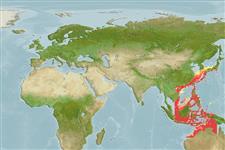>
Eupercaria/misc (Various families in series Eupercaria) >
Nemipteridae (Threadfin breams, Whiptail breams)
Etymology: Nemipterus: Greek, nema, -atos = filament + Greek, pteron = wing, fin (Ref. 45335).
Environment: milieu / Zona climática / intervalo de profundidade / distribution range
Ecologia
marinhas demersal; não migratória; intervalo de profundidade 1 - 220 m (Ref. 9785), usually 18 - 33 m (Ref. 54679). Tropical; 39°N - 20°S, 106°E - 140°E (Ref. 54679)
Western Pacific: southern Japan to northwestern Australia and the Arafura Sea.
Comprimento de primeira maturação / Tamanho / Peso / Idade
Maturidade: Lm ?, range 15 - ? cm
Max length : 35.0 cm SL macho/indeterminado; (Ref. 3810); common length : 23.0 cm SL macho/indeterminado; (Ref. 3810)
Espinhos dorsais (total) : 10; Raios dorsais (total) : 9; Espinhos anais: 3; Raios anais : 8. Suborbital spine absent. Preopercle with 3 transverse scale rows. Pectoral and pelvic fins long, reaching to between level of anus and origin of anal fin. Upper lobe of caudal fin produced to form a trailing filament. A line drawn up from the posterior edge of suborbital reaching the dorsal profile 5 to 7 scale rows before origin of dorsal fin. Axillary scale present. Body color pink, paler below. Head pink, a yellow stripe from upper lip extending to antero-ventral margin of eye. Two faint yellow bars across cheek sometimes present. Pelvic fins with yellow stripes.
Body shape (shape guide): fusiform / normal; Cross section: oval.
Inhabits muddy or sandy bottoms. Young fish generally occur in shallower water between 18 and 33 m. Feeds on crustaceans, fish and cephalopods. One of the most important commercial fish in the East China Sea and northern South China Sea. May be made into fish balls (Ref. 4931).
This species is a rudimentary hermaphrodite in which males have functional testes with rudimentary ovarian portions that remain throughout their life.
Russell, B.C., 1990. FAO Species Catalogue. Vol. 12. Nemipterid fishes of the world. (Threadfin breams, whiptail breams, monocle breams, dwarf monocle breams, and coral breams). Family Nemipteridae. An annotated and illustrated catalogue of nemipterid species known to date. FAO Fish. Synop. 125(12):149p. Rome: FAO. (Ref. 3810)
Status na Lista Vermelha da UICN (Ref. 130435: Version 2025-1)
Ameaça para os humanos
Harmless
Uso pelos humanos
Pescarias: espécies comerciais; peixe esportivo: sim
Ferramentas
Relatórios especiais
Baixar XML
Fontes da internet
Estimates based on models
Preferred temperature (Ref.
123201): 24 - 29, mean 28.1 °C (based on 352 cells).
Índice de diversidade filogenética (Ref.
82804): PD
50 = 0.5000 [Uniqueness, from 0.5 = low to 2.0 = high].
Bayesian length-weight: a=0.01413 (0.01184 - 0.01685), b=2.96 (2.93 - 2.99), in cm total length, based on LWR estimates for this species (Ref.
93245).
Nível Trófico (Ref.
69278): 4.0 ±0.57 se; based on food items.
Generation time: 3.2 (2.5 - 3.7) years. Estimated as median ln(3)/K based on 14
growth studies.
Resiliência (Ref.
120179): médio(a), tempo mínimo de duplicação da população 1,4 - 4,4 anos (K=0.24-0.45; Fec=2,000).
Prior r = 0.91, 95% CL = 0.60 - 1.37, Based on 2 data-limited stock assessments.
Fishing Vulnerability (Ref.
59153): Low to moderate vulnerability (35 of 100).
🛈
Climate Vulnerability (Ref.
125649): Moderate to high vulnerability (48 of 100).
🛈
Nutrients (Ref.
124155): Calcium = 353 [80, 674] mg/100g; Iron = 1.1 [0.4, 3.1] mg/100g; Protein = 18 [16, 20] %; Omega3 = 0.298 [0.148, 0.650] g/100g; Selenium = 49.2 [19.9, 137.2] μg/100g; VitaminA = 9.82 [2.30, 54.41] μg/100g; Zinc = 0.707 [0.413, 2.373] mg/100g (wet weight); based on
nutrient studies.
